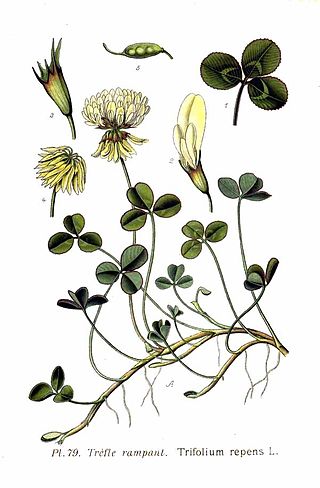
Clover, also called trefoil, are plants of the genus Trifolium, consisting of about 300 species of flowering plants in the legume family Fabaceae originating in Europe. The genus has a cosmopolitan distribution with highest diversity in the temperate Northern Hemisphere, but many species also occur in South America and Africa, including at high altitudes on mountains in the tropics. They are small annual, biennial, or short-lived perennial herbaceous plants, typically growing up to 30 centimetres (12 in) tall. The leaves are trifoliate, with stipules adnate to the leaf-stalk, and heads or dense spikes of small red, purple, white, or yellow flowers; the small, few-seeded pods are enclosed in the calyx. Other closely related genera often called clovers include Melilotus and Medicago.

Trifolium repens, the white clover, is a herbaceous perennial plant in the bean family Fabaceae. It is native to Europe, including the British Isles, and central Asia and is one of the most widely cultivated types of clover. It has been widely introduced worldwide as a forage crop, and is now also common in most grassy areas of North America, Australia and New Zealand. The species includes varieties often classed as small, intermediate and large, according to height, which reflects petiole length. The term 'white clover' is applied to the species in general, 'Dutch clover' is often applied to intermediate varieties, and 'ladino clover' is applied to large varieties.

Trifolium pratense, red clover, is a herbaceous species of flowering plant in the bean family Fabaceae, native to Europe, Western Asia, and northwest Africa, but planted and naturalized in many other regions.

Trifolium subterraneum, the subterranean clover, subterranean trefoil, is a species of clover native to Europe, Southwest Asia, Northwest Africa and Macaronesia. The plant's name comes from its underground seed development (geocarpy), a characteristic not possessed by other clovers.

Trifolium campestre, commonly known as hop trefoil, field clover and low hop clover, is a species of flowering plant native to Europe and western Asia, growing in dry, sandy grassland habitats, fields, woodland margins, roadsides, wastelands and cultivated land. The species name campestre means "of the fields".

Trifolium incarnatum, known as crimson clover or Italian clover, is a species of herbaceous flowering plant in the family Fabaceae, native to most of Europe. It has been introduced to other areas, including the United States and Japan.

Medicago lupulina, commonly known as black medick, nonesuch, or hop clover, is a plant of dry grassland belonging to the legume or clover family. Plants of the genus Medicago, or bur clovers, are closely related to the true clovers (Trifolium) and sweet clover (Melilotus). Like the true clovers, black medick has three leaflets and a small, yellow flower closely resembling those of lesser trefoil. Black medick belongs to the same genus as alfalfa.
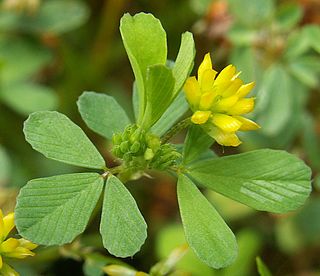
Trifolium dubium, the lesser trefoil, suckling clover, little hop clover or lesser hop trefoil, is a flowering plant in the pea and clover family Fabaceae. This species is generally accepted as the primary plant to represent the traditional Irish shamrock.

Trifolium hybridum, the alsike clover, is a species of flowering plant in the pea family Fabaceae. The stalked, pale pink or whitish flower head grows from the leaf axils, and the trifoliate leaves are unmarked. The plant is up to 40 centimetres (1.3 ft) tall, and is found in fields and on roadsides – it is also grown as fodder. It has been linked with toxicity in horses and has some agricultural uses. The plant blooms from spring to autumn. Originating in mainland Europe, it has become established as an introduced plant in the British Isles and throughout the temperate regions of the world.
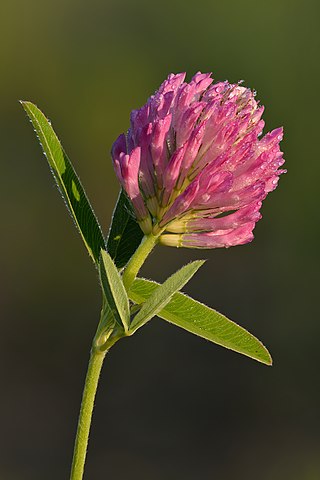
Trifolium medium, the zigzag clover, is a flowering plant species in the bean family Fabaceae. It is similar in appearance to red clover, Trifolium pratense, but the leaflets are narrower and have no white markings and the narrow stipules are not bristle-pointed. The species is native to Europe from Britain to the Caucasus.

Trifolium alexandrinum is an annual clover cultivated mostly in irrigated sub-tropical regions, and used as leguminous crop. It is an important winter crop in Egypt, where it may have been cultivated since ancient times, and was introduced into northern India in the early nineteenth century. It is also grown in the United States, Europe, China and Australia.
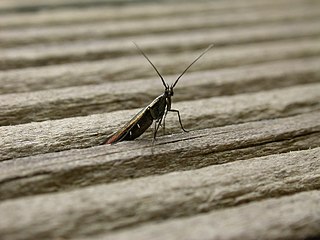
The clover case-bearer or small clover case-bearer is a moth of the family Coleophoridae. It is native to Asia, Europe and North Africa, and has been introduced to Australia and New Zealand.

Trifolium angustifolium is a species of clover known by the common names narrowleaf crimson clover, narrow clover and narrow-leaved clover.
Trifolium breweri, which has the common names forest clover and Brewer's clover, is a perennial clover that is native to mixed evergreen forests and coastal coniferous forests in Southern Oregon and California.

Trifolium glomeratum is a species of clover known by the common names clustered clover and bush clover. It is native to Eurasia and North Africa and it is known elsewhere as an introduced species. It easily takes hold in disturbed areas, becoming a common weed. It is an annual herb growing decumbent to upright in form with mostly hairless herbage. The leaves are made up of oval leaflets up to 1.2 centimeters in length. The inflorescences occur in leaf axils, each a headlike cluster of many flowers. Each flower has a calyx of sepals with triangular points that bend outward, and a pink corolla.

Trifolium hirtum, commonly known as rose clover, is a species of flowering plant in the legume family Fabaceae. It is indigenous to a range of regions spanning Europe, Western Asia, and North Africa, and has been introduced to other parts of the world where it is cultivated for various purposes.

Trifolium ochroleucon, also known as Trifolium ochroleucum or sulphur clover, is a species of clover in the family Fabaceae. It is a perennial and can be found in grassy places, predominantly on clay soils. It is native to Europe, including the British Isles.
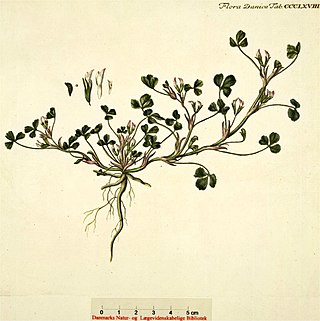
Trifolium ornithopodioides, the bird's foot clover, is a species of flowering plant in the family Fabaceae. It is native to Europe, Madeira, and northwestern Africa, and has been introduced to Australia and New Zealand. It is a halophyte.

Trifolium semipilosum, the Kenya clover or Kenya white clover, is a species of flowering plant in the family Fabaceae. It is native to Yemen, Eritrea, Ethiopia, Kenya, Uganda, Tanzania, Malawi and Zimbabwe, and has been introduced to Saint Helena. It is a close wild relative of the important forage crop Trifolium repens.
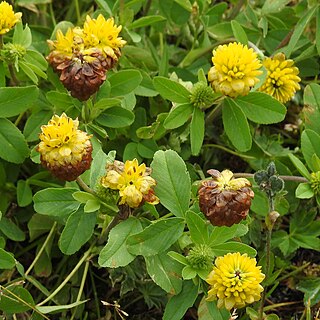
Trifolium badium, the brown clover or brown trefoil, is a species of flowering plant in the family Fabaceae, native to most of mainland Europe, the Caucasus, Turkey, Iraq, and Iran. It is a locally important forage in sub-alpine pastures.


















